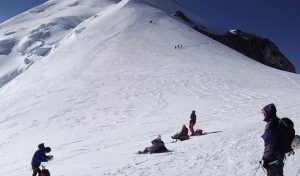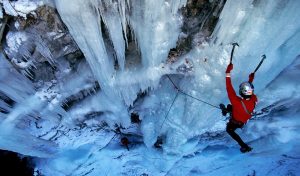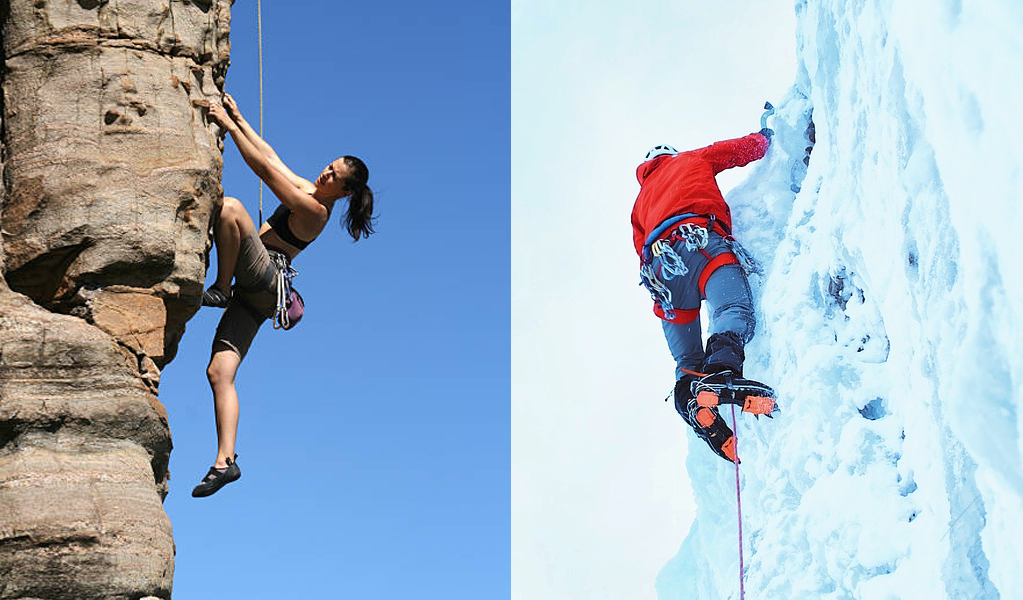Mountain climbing or mountaineering is a profession for some and a hobby for others. Every year, thousands of men and women go for high-altitude climbing in heavy snow.
One needs technical knowledge and experience along with athletic ability to survive among those towering mountains.
High-altitude mountain climbing is the pinnacle of the climbing world. Before you attempt these peaks, remember that you may be incredibly fit at sea level and extremely unfit at heights.
Ascending further away from sea level is a risky activity and a dangerous sport. If you have trained at sea level all your life, you may be a marathon runner or a star athlete, but the high elevation is a totally different ball game.
What is high altitude?

Altitude or elevation is any height above sea level. Altitude is defined in different scales as follows:
- High altitude – can range from anywhere between 8,000 to 13,000 feet
- Very high altitude – can range from 13,000 to 18,000 feet
- Extremely high altitude- exceeding 18,000 feet
What Makes High Altitude Climbing Difficult?
Higher elevation climbing should not be taken lightly and for granted since people have died and continue to die while scaling monumental peaks. It’s a dangerous endeavor, so physical fitness is a must.
Most people climbing higher altitude peaks may not have had sufficient experience before, so being in shape and completing extensive training is the key.
Ascending to higher altitudes has numerous factors that contribute to the level of its difficulty as follows:
1. Low Oxygen
As the height goes up beyond 8000 ft, the air pressure decreases, and the oxygen level drops. In other words, the air pressure gets lesser as you climb up and that means your body gets less oxygen than it normally does. Some people start feeling the effects of high-altitude illnesses at 7000 feet.
It is recommended to give your body time to adjust. As you gain altitude, consider spending 2-5 days at base camp to acclimatize. Don’t push your body beyond 1000 feet a day. Since the air gets thinner at the high elevations, it makes breathing oxygen more difficult.
Lack of oxygen causes Hypothermia (reference), dehydration, and height sicknesses. Some scientists believe that lack of oxygen at the heights causes swelling to the brain and increased blood flow to the brain which causes leakiness of blood vessels in the brain.
Shortness of oxygen also worsens the HAPE sickness, as it increases fluid build-up in the lungs. Therefore, one of the most frequent reasons for falling sick at higher altitudes is a lack of oxygen, and one should not ascend further if they have noticed higher height sickness symptoms.
2. Snow
Weather and snow conditions can make climbing difficult. The unpredictability and the unreliability of weather reports make it even more treacherous.

Many mountaineers have started a climb based on a weather report only to be faced with completely unexpected conditions. Avalanches remain one of the most common causes of death for high-eminence climbers.
At higher altitudes, the weather is much colder, and one can notice snow on the mountains all year long. At the sea level flat land, the climate is dry, and as you ascend to the higher altitudes the temperature drops and it gets moist and colder.
Therefore, snow and icy climate make climbing even harder. Before climbing to high heights, one should make sure to pack the ice and snow climbing equipment (reference) such as crampons, ice axes, waterproof hiking boots, gloves, rope, ski goggles, belay device, and personal first aid kit.
Climbing in snow is much harder than ascending on a dry or rock-climbing mountain. Snow can be soft or hard, in both cases one can have a hard time climbing.
3. Rain
Since the higher elevation temperature is colder and has a moist climate, it is usually raining at the peaks while there is tropical weather at the sea level.
At the heights of the mountains, the cool air temperature is more than the warm air temperature, and the wind carries this air high to the mountains causing more rainfall than ground level. The wet and slippery land has an impact on the difficulty level of climbing.
Continuous rains damage the routes and degrade the rock. The Bureau of Land Management office in St. George, Utah, says “Wait at least a week in winter and early spring and when there is high humidity, cold temperature, and already moist conditions.”.
4. Glaciers
A glacier refers to a large piece of dense and compressed ice that continuously flows and moves under its weight. The top 50 meters of a glacier is hard since it’s under low pressure and therefore, it is also called the fractured and cracked zones.
Glacier climbing can be risky if one does not have the right knowledge and equipment. One of the obstacles glacier hikers experience is crevasses and serac.
Crevasses refer to the fracture or crack found on the ice sheet, and on the other hand, serac refers to a column of glacial ice that is almost the size of a house. Serac is very dangerous for mountaineers as it falls in large numbers. Serac is an obstacle for many climbers at high elevations of K2 mountains and Mount Everest.
Glaciers climbing is difficult to navigate and treacherous terrain for any mountaineer, no matter how experienced. Practice your glacier climbing skills on less dangerous terrain before attempting a high-elevation climb. Make sure your equipment is sufficient to handle glacier climbing.
Safety and Equipment
Remember that not every climb is successful. Be prepared to turn back if conditions are unsuitable. Remember that brain function is compromised at low oxygen levels (especially above 20000 feet) and your decision-making may not be at its best.
Thus, travel with experienced climbers and make no foolish mistakes. Remember to pace yourself. If your ascent to the summit is taking longer than expected, consider putting it off.
A common mistake is arriving at the summit too late and having to face late afternoon storms in the dark while you’re attempting to descend.
Some Basic Equipment Should be in every Climber’s Backpack.
- Sunscreen and sunglasses are critical to getting protection from the sun rays that seem to get harsher with height.
- Snow blindness and sunburn are common and are real problems on the mountain.
- High Altitude Mask
- High Altitude Medication
- Extra clothing is always advisable.
- Carry your own oxygen and water supply as these essentials are extremely dear at higher altitudes.
- An avalanche transceiver is essential to carry that will help to locate them under the worst scenario.
- Helmet and headlamps are a must, and proper water and rations should be carried along.
High Altitude Fitness

It is fundamental to condition your body and mind before attempting a high climb. Aerobic exercise demands much more from your body at lower oxygen pressures.
Your aerobic capacity can be measured by your VO2 max, which is the maximum amount of oxygen your body can consume at a given time. At heights or altitudes, low oxygen pressures are going to decrease your VO2 max, which means that oxygen delivery to your body is compromised and your tolerance is going to drop.
At low altitudes, there are several things you should start doing to maximize your capacity. If you haven’t been training, chances are your VO2 max is not at its peak level and has room for improvement.
Start with medium-intensity aerobic exercises like jogging and running that stress your heart and slowly increase them in intensity.
Practice skills you’ll need on the climb. For example, running upstairs with a heavy backpack or hiking on the treadmill at a steep incline carrying weights will help simulate the situations you may have to face on the climb.
High Altitude Sickness
Altitude sickness is the body’s reaction to the amount of low oxygen at higher elevations. The lower the air pressure at the higher altitudes, the lower the oxygen level drops, which makes it hard to breathe and therefore leads to higher altitude discomfort.
If you try to go fast or hike too high, you may have to deal with higher altitude illnesses and Acute Mountain Sickness. The problem is that hikers are in a hurry to achieve their target and forget that they need to give their bodies some rest. About 75% of people hiking over 10,000 feet experience these problems.
Those mild symptoms can get worse if the hikers continue to go on. Fatigue and dehydration are extremely common. The body throws out water at high elevations, so try and drink at least 5L a day to prevent dehydration, a common rookie mistake. Slow down your pace as you gain height.
Another issue can be High Altitude Pulmonary Edema where excess fluid gets into the lungs, thus reducing the breathing capacity of the lungs. The climber may experience weakness, shortness of breath, and tightness in the chest.
Facts you should know before living at high altitudes:
- High altitude training, getting fit to avoid the low air pressure and oxygen level side effects.
- Adjust to the difference between low and high-altitude baking. At heights above 3000 ft foods are cooked and baked differently.
- If you live in a mountain community, you will notice the effects of high altitude on your car. Make sure to get a car that handles the wind pressure and freezing temperatures at higher levels. The 2017 Jeep Patriot high-altitude car is a good example of having the right car features for living at high elevations.
- Get proper knowledge of health problems and the pros or cons of living at higher altitudes with health issues. However, living at a higher height than sea level is also good for weight loss and lower heart strokes.
Best Places for High Elevation Climbing
There are many peaks well over 14,000 feet that have trails all the way to the top. One such good example is Colorado. Other popular spots amongst mountaineers are Mexico volcanoes, the Caucasus, the Carpathian Mountains, Tatra Moun, the Cascades, the Sierra Nevada of California, the Saint Elias Mountains, and the Alaska Range.
FAQ
What is High-Altitude?
A higher altitude is when you reach high (8000 ft) on a mountain above sea level. As an example, high elevations of the world are considered to be Mount Everest, K2 mountains between Nepal and India, Mauna Kea, and Kanchenjunga. All the mountains mentioned above are the list of tallest mountains which reach altitudes around 29,035 ft and below.
How to Prepare for High Altitude?
Train your body: Before planning to climb at high altitudes, one should train their heart and lungs. Plan to do aerobic exercises such as running, biking, swimming, climbing steep hills, and walking.
- Dehydration: Drink at least 4 to 6 liters of water a day and prepare your body to avoid dehydration.
- Climb high and sleep low (don’t climb more than 300 meters a day)
- Know all the danger signs at high elevations
- Pack your medications
- Carry the necessary climbing equipment along
Why is it hard to Breathe at High Altitudes?
At the peaks of mountains, the air pressure and oxygen level drop. The air is thinner at the heights which makes the oxygen intake harder. When the lungs do not get enough oxygen, it leads to many altitude illnesses. One of the other reasons for high altitude breathing problems is high blood pressure. It requires more oxygen to pump the blood to body parts as the body gets drowsy. One needs to rest and allow the body to adjust to changing altitudes.
How to acclimate to High Altitude Quickly?
Make the transition from low altitude to high heights easier and slower, do not rush to reach high too fast. That’s why they say driving is better than flying to heights since the body gets time to acclimate to the transition.
- Descend to a lower altitude soon if you feel a mild sickness.
- Make sure to always sleep at a lower height than what you have climbed for the day
- Drinking plenty of water and taking high-altitude medicine for better sleep helps the body to acclimate faster
References:
- http://www.altitude.org/hypothermia.php
- https://www.thoughtco.com/when-can-you-climb-on-wet-rock-755255
- https://www.timberlinemtguides.com/equip-lists/ice-climbing-equipment-list/
- http://www.mountaineeringmethodology.com/climbing-in-snow/

cialis 10 doctissimo only best offers cialis use